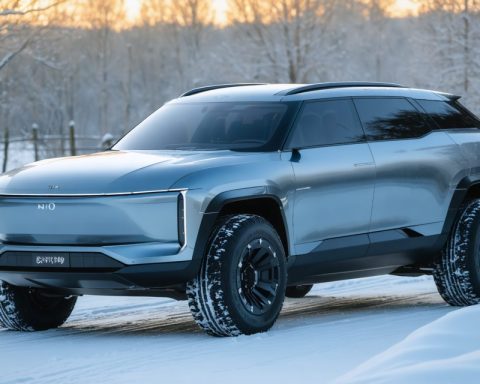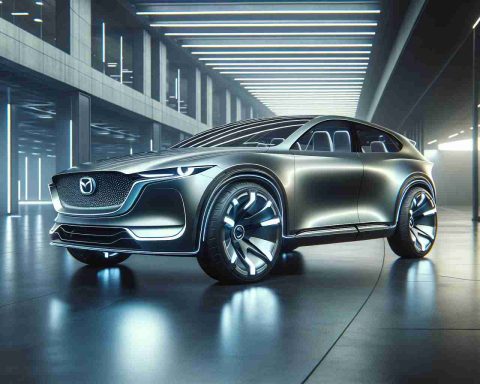- Amsted Automotive is strategically positioning itself as a leader in the off-highway electric vehicle (OHEV) market through innovation and localized manufacturing.
- The company’s commitment to “manufacture in the customer’s region” reduces costs and enhances efficiency amid fluctuating tariffs.
- The Amsted eAxle Disconnect, developed at the Saginaw plant, enables seamless transitions between two-wheel and four-wheel drive, enhancing energy efficiency and extending driving range by up to 10%.
- Amsted’s advanced wheel-end disconnect system allows easy axle disconnecting without altering wheel hub geometry, enhancing versatility and control.
- Innovation and localized production are key to Amsted’s strategy, leading to significant efficiency gains and cost savings in the OHEV sector.
- Amsted Automotive is not just adapting to the electric vehicle revolution but actively shaping its future with cutting-edge powertrain technologies.
Amid the ever-evolving landscape of electric vehicles, one company is making strategic moves to lead the charge in the off-highway electric vehicle (OHEV) market. Amsted Automotive, a name synonymous with innovation in powertrain technology and metal shaping, is poised to reshape the future of OHEVs in the United States.
With a bold strategy rooted in local manufacturing, Amsted Automotive is doubling down on its commitment to “manufacture in the customer’s region.” This not only curtails costs but also enhances efficiency—crucial factors in today’s tumultuous tariff climate. Several of Amsted’s thirteen manufacturing facilities across the U.S. are gearing up to produce high-demand components tailored for OHEVs.
At the heart of their innovation lies the Amsted eAxle Disconnect, a cutting-edge technology born in the bustling Saginaw plant. While currently invigorating passenger electric vehicles, this technology is ready to springboard into agricultural and off-highway arenas. The eAxle Disconnect boasts a seamless transition between two-wheel and four-wheel drive, thanks to its ingenious use of the Amsted Dynamic Controllable Clutch (DCC) technology. This not only boosts energy efficiency but can also stretch driving range by a remarkable 10%, setting a new benchmark in the industry.
On top of the eAxle, Amsted offers an advanced wheel-end disconnect system, which can be crafted at any of its U.S. plants. This electromechanical marvel incorporates DCC within a hub assembly, making axle disconnecting for towing and other maneuvers effortlessly manageable without altering wheel hub geometry.
As Amsted Automotive scales the heights of the OHEV sector, the key takeaway is clear: innovation combined with localized production can lead to profound efficiency gains and cost savings. Through tireless dedication to enhancing powertrain technologies, Amsted is not just participating in the electric revolution; it is helping to steer its course. In a world where adapting to change is the pathway to success, Amsted Automotive is driving full throttle towards a greener, more efficient horizon.
How Amsted Automotive is Revolutionizing the Off-Highway Electric Vehicle Market
Industry Trends and Innovations
The off-highway electric vehicle (OHEV) market is rapidly evolving, with increased demand for sustainable and efficient vehicles. As industries such as agriculture, construction, and mining seek to reduce their carbon footprints, companies like Amsted Automotive are stepping up to meet these needs with cutting-edge technology. Amsted Automotive is renowned for its pioneering efforts in powertrain technology and its innovative approach to manufacturing.
Key Features and Technologies
1. Amsted eAxle Disconnect:
– Technology: The eAxle Disconnect enables seamless transition between two-wheel and four-wheel drive, enhancing vehicle adaptability and efficiency.
– Efficiency Gains: By utilizing Dynamic Controllable Clutch (DCC) technology, it can improve energy efficiency and extend the driving range by up to 10%.
2. Advanced Wheel-End Disconnect System:
– Mechanics: This system incorporates DCC technology within a hub assembly, which allows for easy axle disconnects without altering the wheel hub’s geometry, making maneuvers such as towing much more efficient.
Benefits of Localized Production
Amsted’s strategy of manufacturing “in the customer’s region” has several advantages:
– Cost Efficiency: By reducing shipping and logistics costs, the company can offer more competitive pricing.
– Enhanced Efficiency: Local production minimizes delays and can rapidly respond to market demands.
– Environmental Impact: Decreased transportation reduces carbon emissions, aligning with sustainability goals.
Industry Forecasts and Market Trends
The OHEV market is expected to grow significantly over the next decade, driven by technological advancements and environmental regulations. According to a report by Allied Market Research, the global electric vehicle market size was valued at $162.34 billion in 2019 and is projected to reach $802.81 billion by 2027, growing at a CAGR of 22.6% from 2020 to 2027. Off-highway vehicles will form a critical part of this growth.
Real-World Applications
– Agricultural Sector: Utilization of advanced powertrain technology can improve energy efficiency and reduce fuel costs, making operations more sustainable and cost-effective.
– Construction and Mining: Enhanced vehicle capabilities can lead to longer operational hours and reduced downtime, significantly improving productivity.
Expert Insights and Controversies
Pros:
– Significant improvements in energy efficiency and vehicle adaptability.
– Reduced environmental impact due to decreased emissions.
Cons:
– High initial investment costs for technology integration.
– Potential reliability concerns during the early adoption phase of new technologies.
Actionable Recommendations
– For Manufacturers: Embrace localized manufacturing to reduce costs and enhance customer service.
– For Investors: Keep an eye on companies like Amsted Automotive that are innovating in the OHEV sector for potential investment opportunities.
– For Consumers: Consider the long-term savings and environmental benefits of transitioning to electric vehicles in industrial applications.
For more information, visit Amsted Automotive.
Conclusion
The drive towards a more sustainable future in off-highway vehicles is clear, with companies like Amsted Automotive at the forefront. Through their innovative technologies and strategic manufacturing approaches, they are setting new standards in the industry. As the OHEV market continues to expand, the benefits of adopting these advancements are undeniable, offering both economic and environmental incentives.












